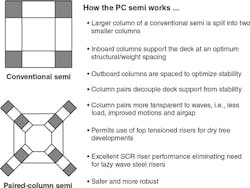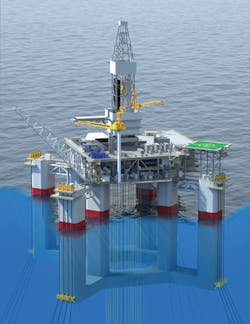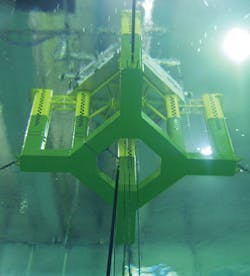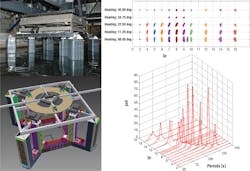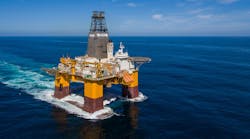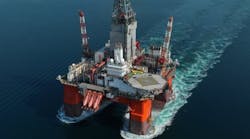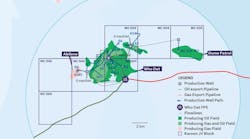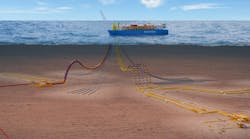Jun Zou •John Chianis
Atkins
The Paired-Column Semisubmersible (PC Semi) is an innovative alternative to the conventional semi. It uses column pairs to increase safety, lower cost, improve project delivery time, and be riser friendly. Thoroughly engineered, model tested, and approved in principle by DNV GL, Atkins’ PC Semi splits the larger single corner column of a conventional semi into two smaller columns to improve platform motions and thus enhance the functionality of the platform.
A conventional semi has four large vertical columns arranged in a square pattern and four horizontal pontoons connecting the lower portions of the columns. These columns form a foundation to support the topsides and provide buoyancy and stability in both pre-service and in place conditions.
Unfortunately, the key design characteristics of a conventional semi are strongly coupled, making it difficult to achieve a “balanced” solution. To achieve suitable motion characteristics for steel catenary risers (SCRs), platform draft is increased which leads to an increase in column spacing or column size in order to meet stability requirements. Increasing column spacing will lead to an increase in deck steel weight which will offset any gains in stability. Increasing column size will lead to more diffraction and wave crest enhancement under the deck resulting in an increase in column freeboard to meet minimum airgap requirements. Stability will be adversely affected due to the resulting increase in vertical center of gravity. Larger column spacing or column size will result in larger environmental loads due to wind, waves, and current resulting in larger mooring line sizes and/or number of mooring lines to meet offset limit requirements.
On the other hand, with its ability to efficiently support the topsides deck with the inboard columns and optimize stability with the outboard columns, the PC Semi addresses the above issues in the following manner. Topsides deck support is decoupled from stability to promote a more efficient and compact design. SCR performance is greatly improved because of low motions and pontoons arranged closer to the center of the platform. Reduced column size means the PC Semi is more transparent to waves and current which reduces wave exciting loads and improves airgap. It is well-suited for either wet tree or dry tree developments in the most severe metocean environments. Conventional off-the-shelf riser tensioning equipment is viable due to reduced vertical motions and low riser stroke.
In addition, the PC Semi has better damage tolerance, flexibility on topsides deck/hull design, and is expandable and easily scalable. It does not require the use of high maintenance components such as hinges, suspended hydrodynamic plates, or any other moveable parts.
Development history
The idea for the PC Semi was first introduced in 2008, and it was ultimately selected by Research Partnership to Secure Energy for America (RPSEA) as the winning concept for a dry tree deepwater development program. Computational studies were confirmed by wind tunnel and wave basin model tests. A series of subsequent engineering efforts were performed on such contemporary issues as vortex induced motion (VIM) response and characteristic structural responses including shear forces and pry/squeeze loads.
A brief summary of the PC Semi development history is as follows:
- 2008: Introduced by Houston Offshore Engineering, now an Atkins company
- 2009: Selected by RPSEA in an industry-wide competition
- 2009: Wind tunnel tests completed at Texas A&M University
- 2009: Technology Review with the Bureau of Ocean Energy Management and the United States Coast Guard
- 2010: Wave basin model tests performed at Offshore Technology Research Center
- 2010: Technology Readiness Review by RPSEA
- 2011: DNV GL Technology Assessment and Workshop
- 2013: VIM model tests completed at Maritime Research Institute Netherlands
- 2014: Approval in Principle awarded by DNV GL.
A significant effort spanning nearly eight years has resulted in the PC Semi being declared “Major Capital Project Ready” for the Gulf of Mexico. Within this time period, the technology has also been applied to offshore Western Australia and Brazil. In addition to its more traditional applications, the PC Semi has also been designed for small floating liquefied natural gas (FLNG) production offshore Western Australia.
Benefits
The key benefits of a PC Semi are measurable, and taken as a whole, form a strong value proposition when compared to a conventional semi. Safety, low cost, efficient delivery, and its effectiveness as a riser host are discussed below.
Safety. The PC Semi is fully capable of quayside integration. This simplifies offshore installation operations, reduces offshore working hours, and minimizes installation risk. It is robust and has improved damage tolerance. For example, outer columns provide protection to the inner columns for accidents such as boat collision. An eight-column hull has less impact on stability due to flooded compartment scenarios. The paired-column arrangement not only offers the best protection to all top tensioned risers (TTRs) in the wellbay for the dry tree configuration, but also offers the best opportunity to route all hard piping on the hull away from potential impact locations.
Low cost. At a project level, the PC Semi has cost advantages for both capex and opex. Low capex comes from the following aspects. It is capable of quayside integration. Deck steel weight is reduced due to optimized inner column spacing and smaller pry/squeeze loads. Hull steel weight is reduced due to smaller platform displacement and associated reduction of global shear forces, split loads, and pry/squeeze loads. Response characteristics are improved from wind, wave, current and VIM, resulting in more efficient mooring and riser systems. The mooring system can be reduced by smaller line sizes and/or the number of mooring lines. The potential need for lazy wave steel risers is eliminated as conventional and lower cost SCRs can be used. The paired-column hull permits flexibility during fabrication and enables a fasttrack execution plan. Late increases in topsides payload can be handled efficiently.
Due to more favorable motion and VIM response characteristics, opex is also low because it is not necessary to perform mooring pay-in/pay-out to shift the touch down points of risers in order to mitigate potential strength and fatigue issues. Also, there is no need to adjust chain links at fairleads to mitigate potential fatigue due to out-of-plane and/or in-plane bending.
Enabling the use of dry trees on a semi can lead to further savings through drilling from the platform, using a smaller rig for completions and workovers, using electrical submersible pumps for downhole pumping, and simpler well maintenance leads to more production.
Fasttrack delivery. The spacing between inner columns depends solely on the optimized support location for deck structure and can be determined and frozen at an early stage of the project. The requirements on stability and buoyancy can be met by adjusting either the distance between the inner and outer columns, the outer column size, or a combination of both. This can be done at a late stage of the project without much penalty. Thus, the paired-column arrangement permits maximum flexibility from the start of the project throughout its entire project lifecycle.
Riser friendly. Extensive wave basin model tests have been performed to validate the suitability of the PC Semi with a conventional off-the-shelf riser tensioner for dry tree applications. The test results and associated post analysis, decisively confirm riser stroke is within an acceptable range, even in the central Gulf of Mexico region for 1,000-year hurricanes. Additional studies comparing the PC Semi with the truss spar were also performed.
VIM for floating deepwater structures plays a significant role on both the strength and fatigue of mooring elements and SCRs. The PC Semi underwent extensive VIM model testing for mooring and SCR design and analysis. The number of columns and column slenderness all contributed to it demonstrating highly desirable VIM results. The PC Semi is a proven riser friendly host for both TTRs and SCRs.
Conclusion
A conventional semi for the production of oil and gas has one large column per corner. Creation of a column-pair is a simple geometry change that results in two important benefits:
- The inboard columns support the deck, topsides equipment, and all associated environmental loads at an optimum structural spacing. The outboard columns are spaced independently in order to optimize hydrostatic stability.
- The paired-columns lead to improved motions which enable improved platform functionality.
The decoupling of deck support from stability promotes a more compact and efficient design, and allows topsides and hull designers to work independently. The smaller column pairs are more transparent to waves and current, thereby reducing wave exciting loads and improving airgap.
The PC Semi has been model tested for critical current conditions and was found to have excellent VIM characteristics. The platform’s low motions and favorable VIM characteristics make this semisubmersible an exceptional riser host. Should the development call for a dry tree floater, the PC Semi can also support drilling and dry trees. TTR stroke was found to be within off-the-shelf tensioner design limits. It is able to handle harsh deepwater environments in the Gulf of Mexico, offshore Western Australia, and Brazil.
Thoroughly engineered, model tested, qualified, and approved in principle by DNV GL, the PC Semi is the previously missing piece from a complete portfolio of deepwater platform concepts: a low-motion semi which, 1) allows exceptional SCR riser performance in a wet tree configuration, and 2) permits drilling and the support of surface trees in a dry tree configuration. All critical maturation works have been extensively developed, carefully examined, and thoroughly validated.
References
1. Zou, J., “Dynamic Responses of a Dry Tree Semisubmersible Platform with Ram Style Tensioners in the Post-Katrina Irregular Seas.” International Society of Offshore and Polar Engineering Conference 2008, Vancouver, Canada.
2. Research Partnership to Secure Energy for America; RPSEA (2009-2010). “Ultra Deepwater Dry Tree System for Drilling and Production,” RPSEA UDW 1402, Stage 1 Final Report and Stage 2 Summary Report, H08130-G-RPT-GN-15002 & H08130-G-RPT-GN-15003.
3. Zou, J., Poll, P., Antony, A., Das, S., Padmanabhan, R., Vinayan, V., and Parambath, A., “VIM Model Testing and VIM Induced Mooring Fatigue of a Dry Tree Paired-Column Semisubmersible Platform,” Offshore Technology Conference 2014, Houston, Texas, USA. OTC 25427.
4. Zou, J., and Chianis, J., “Paired-Column Semisubmersible Platform for Wet Tree with Steel Catenary Riser Application in Offshore Western Australia.” 1st International Conference on Ocean System Engineering, 2011, Seoul, Korea.
Whatever happened to dry trees in the Gulf of Mexico?
Of the 42 floating platforms in the US Gulf of Mexico, a great majority accommodate dry trees. Why? Presumably, the Gulf of Mexico producers used dry trees because this type of development increased the value of their investment. Lately, however, there has been a noticeable shift to wet tree developments. This shift can mostly be attributed to hub-type developments where multiple fields are produced through a single floater or to situations where a single reservoir is too spread-out to accommodate one drilling center. But it also seems true that producers are sometimes opting for wet trees, even if the reservoir enables a single drill center. Advantages of dry trees include:
- Subsea kit is very expensive, especially for not-yet-approved 20K psi systems.
- Completions and workovers can use a small inexpensive rig.
- If it makes sense, full drilling is available.
- For supplemental lift, downhole pumping using proven ESPs are less costly, more reliable with platform rig access, and use far less power when compared to seabed pumping.
- Simpler well maintenance leads to a greater number of barrels produced.
Perhaps a reason for this trend toward wet trees is that traditional dry tree platform types, TLPs and spars, have at least partially fallen out of favor. The TLP has water depth restrictions. The spar has size restrictions and does not enable quayside integration. Maybe the answer is a low-motion, low-cost semisubmersible that could trigger a return to more economical dry tree developments. Is the PC Semi this vehicle?

